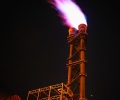Warmer weather, strong gas supplies seen easing winter heating costs

A warmer winter forecast for most of the US and strong natural gas production that has replenished storage inventories are feeding expectations of slightly lower heating expenditures this winter compared with last, the US Energy Information Administration said in its 2019-20 winter fuels outlook.
Overall, the agency forecast a 1% decline in natural gas and electricity bills on average, despite estimates that higher retail gas prices would increase expenses for homes that heat with gas in the Midwest and the South. Residential gas prices are forecast to see a 3% rise amid a 4% decline in residential gas consumption on warmer weather.
“The main takeaway here is that milder forecast weather leads to lower forecast expenditures across the board,” said Tim Hess, product manager for EIA’s Short-Term Energy Outlook, pointing to assumptions that there will be 4% fewer heating degree days this winter than last. “But for customers who heat with gas or electricity, those declines are expected to be quite modest as the temperature effects of lower consumption are offset by slightly higher residential prices.”
Residential gas prices in the Midwest are forecast to be nearly 8% higher this winter than last, and prices in the South and West are seen about 5% and 3% higher, respectively, while Northeast prices are forecast to decline 6%, helped by relatively low global prices for LNG and lower household natural gas consumption.
The overall slight decline in heating expenses is aided by generally declining commodity prices, EIA said.
For the winter, defined as October through March, EIA expects prices at Henry Hub will average $2.56/MMBtu, down 24% from last winter.
PRODUCTION GROWTH
According to EIA, record growth in US natural gas production put pressure on spot gas prices in 2019, despite high levels of exports and increased power sector consumption.
“In general, EIA expects Henry Hub spot prices to remain lower than last winter as production has grown steadily through 2019, leading to a strong storage injection season and leaving supplies ample heading into winter,” said Hess. “However, as you can see in recent winters … there have been spikes during periods of cold that have caused Henry Hub prices to rise for periods of several days, and these have affected monthly average prices.”
EIA, in its October Short-Term Energy Outlook, raised its fourth quarter 2019 production forecast by 0.59 Bcf/d to 101.36 Bcf/d and its Q1 20 production forecast by 0.26 Bcf/d to 100.49 Bcf/d.
“Although the United States remains on track to set new records for dry natural gas production in 2019 and 2020, EIA believes that low natural gas prices will cause production to start to level off going into 2020,” said the agency’s administrator, Linda Capuano. The October STEO expects production to increase in 2019 by about 10%, exceeding 91 Bcf/d, year on year, while 2020 will experience a smaller increase to more than 93 Bcf/d, if the forecast holds.”
The agency lowered its natural gas consumption estimates by 0.28 Bcf/d to 89 Bcf/d for Q4, and by 0.52 Bcf/d to 101.82 Bcf/d for Q1 20.
STORAGE OUTLOOK
Capuano emphasized that natural gas storage has seen a significant rebound, after starting the injection season almost 30% below the prior five-year average. By the end of October, EIA expects working inventories to be 3.792 Tcf, 2% above the prior five-year average and 17% above October 2018 levels.
EIA lowered its forecast for Q4 Henry Hub natural gas spot prices 1 cent to $2.43/MMBtu. The Q1 2020 forecast was unchanged at $2.70/MMBtu. For full-year 2019, Henry Hub natural gas prices would average $2.55/MMBtu, and $2.75/MMBtu in 2020, down from the previous month’s estimates of $2.62/MMBtu and $2.77/MMBtu, respectively.
In assessing the winter outlook, EIA officials emphasized that weather can be unpredictable. Under a 10% colder-than-forecasts scenario, residential gas consumption would be 4% higher than last winter and gas prices would be 2% higher, pushing household expenditures up 7%.
Source: Platts

 Hellenic Shipping News Worldwide Hellenic Shipping News Worldwide, Online Daily Newspaper on Hellenic and International Shipping
Hellenic Shipping News Worldwide Hellenic Shipping News Worldwide, Online Daily Newspaper on Hellenic and International Shipping























 PG-Software
PG-Software